Review PDA HP iPaq hx2110
Standard kit:
- PDA
- Cradle (only in senior modifications)
- Charger
- Plastic screen cover
- 2 CDs with software
- Manual
HP strictly follows its schedule of announcements: basic announcements - in summer, the rest (business models) - in autumn. The year 2004 didn't make an exclusion - basic announcements were held in summer, and the announcement of the business series iPaq hx2000 - late in autumn (a year earlier there were the iPaq h4150 and 4350). In 2005 the situation will likely be the same, only communicators will be out of the schedule.
HP has a vast model line, all devices can be divided into the following categories: budget (HP iPaq rz1710, the review available here), multimedia (the iPaq rx3000 series, the review available here), business (the hx2000 series, we review it today), Hi-End (HP iPaq hx4700, the review available here), communicators (the h6000/hw6500 series). There is another classification offered by HP in the context of target auditorium: for customers (the rz1710 and the rx3000 series), for small business (the h2210, the hx2000 series) and corporate (the hx4700, the h6340).

The hx2000 series goes under the code name Morpheus. I'd note, this model is produced by LG instead of HTC, as it was expected. It was surprising, besides the product turned to be of high quality, which is more typical for HTC than for LG. By the way, the junior model iPaq rz1710 is also made by LG.
The iPaq hx2000 series follows the successive PDA iPaq h2210. The specs have got wider with Wi-Fi and a higher capacity battery, nothing is affected. The iPaq 2210 was taken out of production in December 2004 to be replaced with the new series. Today we write about the junior modification - HP iPaq hx2110, and later - about senior modifications. The iPaq hx2110 has in fact the same specs as the iPaq h2210 (similar dimensions, battery capacity, screen quality, price, however there is no cradle in the standard kit).
Modification and general features
There are three modifications of the new HP model. See the comparison table below. The green color shows differences that improve the characteristics, the orange color - worsen them. If some characteristics are the same for all modifications, the line has no coloring.
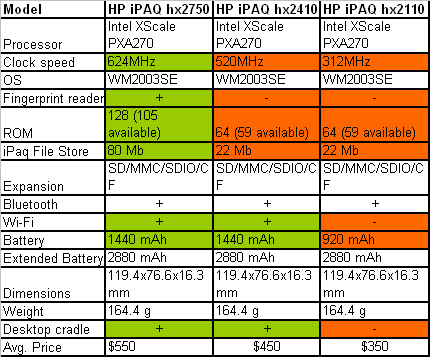
The casing is the same for all modifications, despite of the fact that the junior model has neither a capacious battery, nor a fingerprints scanner. Well, the approach for the rx3000 series is applied here. The production cost is less - there was no need to redesign the casing and make a new press-form at the plant.
The senior model has utmost features: the maximum memory size, the highest clock rate, two wireless adapters, a fingerprint scanner, a cradle. It's notable, some specs exceed the top model iPaq hx4700 (RAM size, the fingerprint scanner).
The main distinction of the mid model is the lack of the fingerprint scanner. Other deteriorations aren't that important for Pocket PC - these are the clock rate and RAM size.
The junior modification is simplified at the most - it lacks a capacious battery, Wi-Fi module. It makes it similar to HP iPaq 2210.
Design, control elements
The design of the hx2000 series stands out of the general concept by HP, it is less strict, more rounded so to say. However the color solution remained the same - the mix of black and grey. Besides it's other than the iPaq h2210. The sides contain rubber insertions. The handheld leaves pleasant emotions when on photos and alive. We should admit the experiments with design proved to be a success. To my mind, this handheld stands in the same line with the iPaq h1940 considering the appeal. But I'm sure some of you won't agree with it.

The new model has slightly larger dimensions than the iPaq h2210, however you'll notice it only when you place both handhelds nearby. So you can neglect the difference, which is the result of a more capacious battery in the senior modifications and a fingerprint scanner. By the way, if we compare the handheld with Asus A730, the dimensions of both models will agree. Let's compare it with other handhelds:
- HP iPaq rx3710: 114.3x71.2x16.3 mm 158.1 g/li>
- HP iPaq h2210: 115.4x76.4x15.4 mm 144.2 g
- HP iPaq hx2110: 119.4x76.6x16.3 mm 164.4 g
- FS Pocket LOOX 710: 122x72x16.1 mm 180 g
- Dell Axim X50: 119x73x16.9 mm 167 g
The device could have been lighter, however its competitors have analogues weight. The shell feels secure, if you squeeze the device in your hand, you'll hear some creaks (there is no backlash, just sound), but you can neglect it easily. The battery compartment cover is safely fixed. The plastic is pleasant to touch. I found it nice that the sides are rubberized, so the shell doesn't slide in the hand. If you remember, the iPaq h2210 had a serious drawback along with all its advantages - the rubber side insertions used to fall off with time. The problem had even aggravated, gradually that side insertions had become a rare accessory, and even self-made tuning details emerged (of metal and wood). The construction of side insertions in the new model doesn't make you doubt it's unsafe (they aren't attached to the shell, they are a part of it).

Have a look at the buttons surrounding the joystick, you'll realize the form was dictated by design and not ergonomics. Two excessively big and two small buttons. Despite of such peculiarity in design of buttons, it's possible to adjust to them in games. There is an empty space between the screen and buttons, here is located the joystick in senior modifications. Besides there are a relatively loud built-in dynamic and a mic (it records well within short distances, up to a meter).

Above the screen there are two LED indicators, a HP logo and a power button. At the left side you see a voice recorder button, it's also rubberized and tight, you have to make an effort to press it. At the bottom end you find a reset button and a standard connector for the cradle, the cable or the AC adapter. The top end elements are comfortably located, they do not mix up: a SD/MMC slot (SDIO), a Compact Flash slot, a 3.5 mm headphones jack, an infrared port and a silo. The sound in the headphones is of perfect quality, you can use the PDA as an MP3 player. The stylus is like any other from the new HP line.

The back panel has the battery compartment, a couple of standard stickers and nothing more.
Kit
Unlike the senior modification HP iPaq hx2110 has a Spartan package, only essential stuff is included (software, a charger, a synchronization cable, no cradle).

I'd note the screen cover. It is fixed at sides and is easy to remove. The cover is translucent, you see the screen well. You can open it to work with the handheld in the usual way, the cover doesn't interfere, even if the headphones are plugged. The minus here is that the cover hides all control elements except for the voice recorder button. In all, the screen cover proves to be a right thing, it's high time to realize something of the kind (there is no need to carry the device in a case, as the main vulnerable art of the PDA, the screen, is protected).
Screen
The hx2110 is equipped with a typical screen for mid range and low end Pocket PCs featuring a transflective TFT matrix with a 3.5" diagonal and a 320x240 pixel resolution. It perfectly renders colors indoors and outdoors, it is good under the direct sunlight. It's a best screen among the analogs (320x240 pixels), comparable with the h2210. There are 21 backlight levels, the lowest level has the quality comparable with the h2210. That means, it's comfortable to work with in the dark, the backlight doesn't hurt eyes, as it happens with some PDAs, those minimum backlight level is high.
Being one of the best among 3.5" 320x240 screens, it can't be compared with VGA screens of top handhelds.

Battery
The PDA has a removable Li-Ion battery capacious of 920 mAh (1440 mAh in senior modifications), the offline performance isn't outstanding. On the other hand, you can always buy an extended battery.

Our tests revealed that under the maximum load (the highest backlight level, video playback, wireless adapters on) the PDA lasted 2 hours 28 minutes. In the MP3 player mode (the screen off, the playback from the storage card) the handheld was good for 11 hours. There are two extended batteries available, capacious of 1440 mAh and 2880 mAh (they are compatible with the iPaq rx3000 series and sold together with an extra charger). We'd run additional battery life tests for the senior modifications.
Interface
The iPaq hx2110 comes with a single built-in adapter Bluetooth, there is no Wi-Fi.
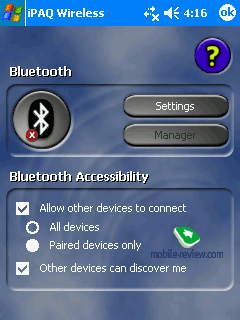

Bluetooth. Traditionally for HP this model comes with time-proved Broadcom drivers. All necessary profiles are available, including the voice profile. We faced no problems with Bluetooth functionality, all profiles worked smoothly: Internet access via the phone, data synchronization with PC, exchange of files and contacts and so on. The driver's version is 1.5.0 Build 2900. There is the support of several simultaneous connections.
 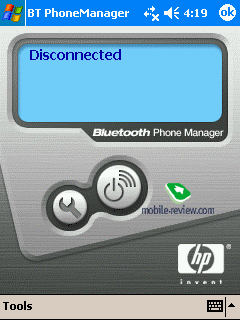
I'd mark a useful utility - BT PhoneManager. It helps in setting Internet connection via the phone (you only need to know access point, login and password).
Productivity, RAM
The handheld has 64 MB of RAM onboard. The available RAM claimed is 60 MB, however the startup takes some 12 MB. Finally we have about 47 MB RAM available. The iPAQ File Store makes up 22 MB.
The PDA is powered by Intel XScale PXA270 312 MHz processor. As far as I felt, all built-in applications work fast enough. The switch from the portrait to the landscape mode takes 1.5 seconds. For the SPB Benchmark test we've chosen models supporting Bluetooth, including relatively old models. And got unusual results…
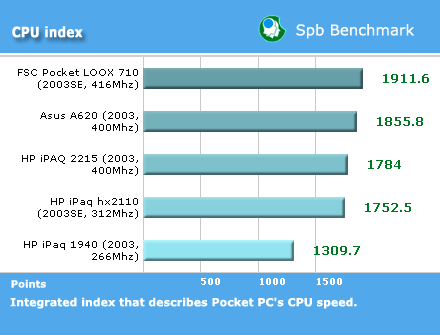
This index describes Pocket PC's CPU speed. Though the clock rate is 312 MHz the PXA270 processor keeps up with the previous generation processors featuring 400 MHz.

The file system index describes Pocket PC file system speed (read/record/move). All models have almost similar results.

The platform index describes total Pocket PC platform speed including the built-in applications. It's interesting that the hx2210 outpaces even the LOOX 710, which works on the same processor, but with higher clock rate.
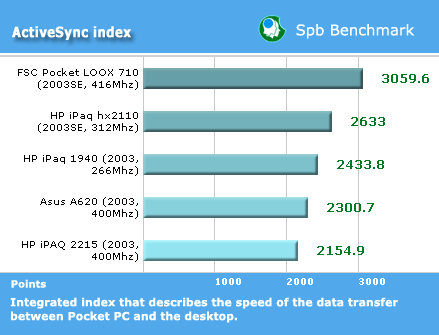
The synchronization speed of the new PDA by HP is high, slightly lagging behind the leader.

Integrated Spb Benchmark index describes total Pocket PC speed. The hx2110 comes with a good result, a best one among QVGA PDAs. But you shouldn't think that the iPaq h2210 has a speed lag, as a matter of fact the speeds of both handhelds are about the same (the SPB package has some serious defects, which are not yet removed).
We'll offer you test results in real applications, they are close to the truth. During the video playback the PDA performed well. In particular, Wireless MMX optimization wasn't involved, we played 4 clips at different stream intensity, the index was formed on the basis of dropped frames. A higher index implies less dropped frames. The index 1000 means that there are no dropped frames at all.

To test graphics productivity we ran tests of the PocketQuake game in the mute mode (turn the sound off by nosound 1 console command, leaving other settings unchanged). It's an averaged figure by two tests (Demo 1 and Demo 2). The results confirmed our expectations:

In result: the iPaq hx2110 is productive enough to complete most tasks, including video playback in acceptable quality and the launch of resource-intensive games and applications. In case if you need higher clock rate for a particular task, it's possible to speed up the processor (the only possible problem here is the hard reset with the loss of all data). For example, we've sped up the processor by XCPUScalar and measured productivity growth with Beta Player, Wireless MMX optimization on. The device revealed a good potential for the speed-up, it performed stable at 416 MHz and 520 MHz. Higher rates provoked hangs and unsteady work. The LOOX 710 behaved the same way - stable at up to 520 MHz clock rate and then pending.
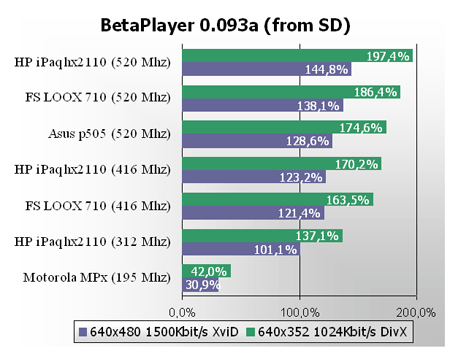
Software
The handheld is powered by Windows Mobile 2003 for Pocket PC Second Edition. Now let's pass over to non-standard built-in applications.
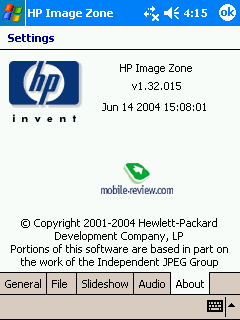 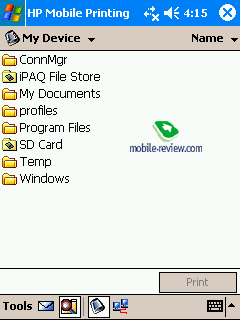
HP Mobile Printing. The utility prints files from the PDA by means of Bluetooth or infrared port.
 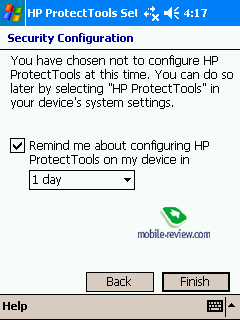
HP Protect Tool. It protects info - data encoding and protection from an unauthorized access.
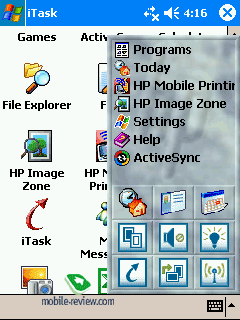 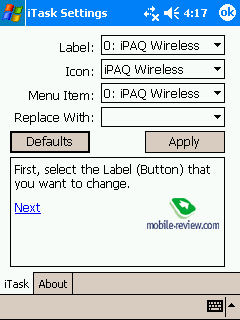
iTask. It's a task manager to switch among the programs and close them. Note, with its help you can rotate or switch the screen off.
 
HP Image Zone. The traditional application by HP to view photos.
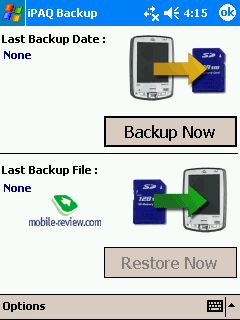 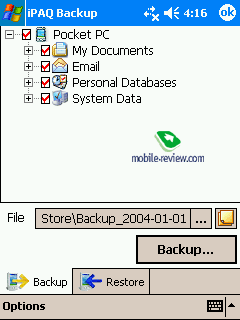
iPaq Backup. This is a functional utility for the data backup, one of the best in its class. It can run backups on the schedule, store the data of the organizer in the iPaq file Store.
ImpressionsHP iPaq hx2110 completely replaces the iPaq h2210 on the market, the latter has been already taken out of production (lower clock rate doesn't count, it get sped up easily). The price tag of $350 forms the bottom line of the mid price range. The stocks of the iPaq h2210 are sold out at a similar price. By the end of the life cycle (November 2005) we should expect a price cut to $280-300.
The main rival of the iPaq hx2110 is the junior modification Dell Axim X50 416 MHz. There are two slots for extension, Bluetooth, no Wi-Fi, other features are the same. At the US market the Dell model looks more attractive with its lower price (currently $270). At the European market the prices are comparable, it's hard to single out the leader. The buyer's choice will be defined by design and brand loyalty, rather than by the difference in the price or features (HP has all chances to win this battle).
FS Pocket LOOX 710 competes with senior models the hx2410/hx2750 and the senior modification of Dell X50, that's why we don't take it into account here. The review of the hx2410/hx2750, including the comparison with the LOOX 710, we'll publish later on.
Despite of the fact, the model was produced by the Korean LG, the device turned to be sold, the assembly quality is high. We liked the design, it's not typical for a PDA, the handheld has its own style. The model combines relatively small dimensions, dual expansion slot, Bluetooth and a good screen. That is, all the things that had made the iPaq h2210 the bestseller. There is nothing brand new in the hx2110, if we compare with the iPaq h2210.
The major shortcoming of the handheld is its short battery life. Besides we wanted to see a VGA screen instead of QVGA. But the screens with a 640x480 pixel resolution are available only in expensive, top Pocket PCs. Another minus here is a poor standard kit and the set of preinstalled applications.
Description
- Class: business
- Position in the line: under the iPaq hx2410, replaces the iPaq h2210
- Operating system: Windows Mobile 2003 Second Edition
- Processor: Intel XScale PXA270 312 MHz
- RAM: 64 MB (59.55 MB available)
- ROM: 22.06 MB available
- Connectivity: SD/MMC slot (SDIO), Compact Flash Type II, IrDA, Bluetooth 1.2, USB 1.1 client
- Screen: 3.5" (active zone: 53x71 mm) 240x320 pixels, 65K colors
- Battery: removable Li-Ion 920 mAh
- Dimensions: 119.4x76.6x16.3 mm
- Weight: 164.4 g.
Anton Kotov (anton.kotov@mobile-review.com)
Translated by Anja Rytchkova (anja.rytchkova@mobile-review.com)
Published — 4 April 2005
Have something to add?! Write us... eldar@mobile-review.com
|






























